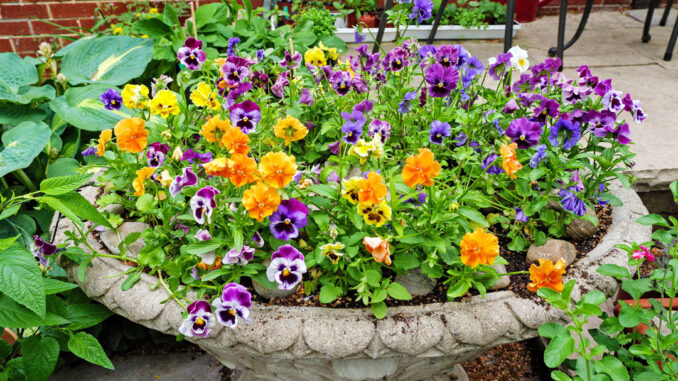
Returning from a sunny journey, the home turf might be a bit rough. But consider what a lawn really needs to get off to the best start. And while you’re at it, plant some quick and lasting flowers that are tougher than you think.
Waking up the lawn
At long last, spring temperatures and longer daylight hours signal the end of the cold months and the beginning of a new growing season. When daytime temperatures reach 15 to 20 degrees Celsius, soil will be sufficiently warmed to stimulate the first hints of green in the rough winter lawn. But hold back on the fertilizer and don’t spoil the newly emerging blades with too much love. They need simple care and a gradual start to promote the thick carpet you look forward to. Here’s what you can do in spring to promote a healthy lawn for the coming summer.
Gentle raking:
Gently go over the lawn with a flexible leaf rake, removing winter debris such as excessive leaves and twigs. Avoid aggressive raking that can rip up sod and disturb new growth already beginning. This is an opportunity to evaluate the turf and look for troubled areas such as the bald patches and thick mats of fibrous thatch caused by excessive nitrogen fertilizer applied in previous seasons. Thatch blocks oxygen and moisture from reaching the root zone and should be removed, leaving a bald area ready to be patched. If thatch patches are particularly resistant, a thatch rake will make the job easier.
Check soil condition:
Did melting snow drain efficiently in early spring? Slow snow melt forming lakes and puddles indicates that compacted soil is under the lawn. Soil compaction robs lawns of the oxygen needed for growth and is inefficient in moving water down to grass roots. Core aeration will help to break up compacted clay soil and improve summer lawn growth. A core aeration machine can be rented, or a lawn service can do the work.
Repair and seeding:
Turf grass seeds germinate best in mild air temperatures between 15C and 24C. (Soil temperature will be about 10 degrees cooler in the root zone.) Purchase a grass seed mix appropriate to your garden light conditions. Seed mix packages contain more than one type of turf seed and will indicate bright sunny locations, shade areas or mixed light conditions. Grass seeds require different periods of time to reach germination, but at least one of the seeds in every mix will be an early starter that you can soon notice germinating. For a quick start, ryegrass and fescue will sprout in five to seven days, if planted in optimum conditions. Kentucky bluegrass seed takes longer, 10 to 21 days, and is often mixed into a quicker-germinating seed mix.
To patch bald spots, scratch up the soil to make a slightly rough surface, sprinkle seed over, then gently cover with peat moss, compost or fine soil gently firmed in place. Covering the seed is essential and will protect it from drying out and blowing away. Keep the repaired spots wet with a daily sprinkling of water, continuing for two weeks after grass blades begin to emerge.
A thin lawn can be thickened by top dressing the entire area with seed and a compost material. If light conditions have become brighter when trees are removed, or new structures have made shade, select a seed mix that suits these new factors.
Fertilize:
It’s time to feed the lawn in late April through late May, after new root growth has been accomplished. Applying fertilizer too early in the spring will produce quick green growth, but at the expense of the healthy roots needed in the coming summer heat. Grass plants need to grow fresh roots in early spring and will do so before producing substantial blade growth. Forcing the plants to put up blades too quickly will neglect root growth and make the lawn vulnerable to summer die-back in periods of heat and drought.
When selecting a lawn fertilizer, avoid high amounts of nitrogen (the first number in the analysis printed on the bag). Too much nitrogen promotes excessive growth and poor drainage, and can result in serious problems such as thatch buildup and oxygen starvation. There are many dozens of fertilizers to choose from and, despite promises on the packages, it’s best to keep your eyes on the numbers. Despite the prominence of high-nitrogen fertilizers in garden centres and hardware shops, you’re better off with a fertilizer that keeps the first number less than 20. There will be many to choose from – you might find fertilizer with an analysis such as 20-10-10, and that would be acceptable at the upper limit. A fertilizer with numbers such as 10-15-10 or 13-5-8 would be even better choices. Just try to keep the first number no higher than 20. Soon, it will be time to remove shoes and walk on the lovely soft lawn.
Pansies: sweet faces, tough characters
Is any flower more emblematic of spring than a bright and jolly pansy? Pansies are sold for early containers and shady border planting. The classic whiskered faces are produced in a full palette of colours and will bloom for six to eight weeks in spring through early summer. They prefer moist, cool conditions and are unfazed by a light spring snow, but will collapse in summer’s high heat.
Spring containers planted with pansies are often emptied, the plants discarded and replaced with summer annuals for the hot growing season. But summer annuals can become exhausted in late summer, and finding a replacement to freshen containers through the autumn months isn’t always successful. If the pansies can be retained and brought back in late summer, they will make a fresh display lasting until hard frost.
Lift the pansies from spring containers and plant them in a shady and cool section of the garden. Lighter-weight containers with pansies can simply be moved to shady corners. Trim back trailing stems and damaged foliage and be sure to provide water throughout the intense summer weeks. As soon as nights are cool, the pansies will put on new growth and begin to look like their spring selves. Replace exhausted summer annuals with the rejuvenated pansies, and the new display will thrive in the cooling air. In the case of a light snowfall, cover the pansies briefly and they’ll be willing to carry on through late autumn weather.


